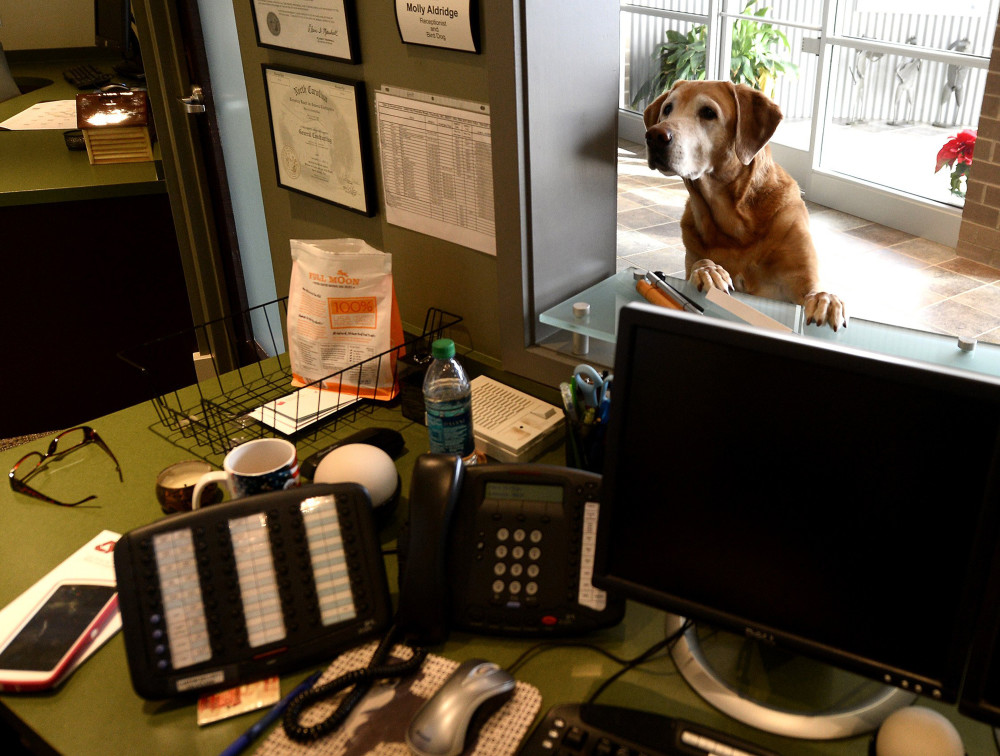By Mai Hoang
Yakima Herald-Republic, Wash.
WWR Article Summary (tl;dr) As companies grapple with how to provide a more flexible work environment for working parents, managers at the Field Group, a Washington advertising firm, are doing everything they can to accommodate employees. For this company, that includes empowering women, if needed, to bring their babies to work.
YAKIMA, Wash.
Keely Murphy Pickerel felt anxious last year as she shared news of her pregnancy with managers at The Field Group, the Yakima advertising and marketing firm where she had just started a few months earlier.
Managers were quick to put Murphy Pickerel at ease. Not only did they express delight, they asked if she was interested in flexible work options, including bringing the baby to the office.
Nearly two weeks ago, the 32-year-old copywriter and project manager returned to work with her 3-month-old daughter snuggled on her chest.
As part of the arrangement, Murphy Pickerel brings her daughter to the office twice a week and works from home two other days.
Today, on her first Mother’s Day, Murphy Pickerel has reason to celebrate: “I feel like it’s the sweetest gift that I can have my baby on my chest and be at work.”
While the option, for the most part, remains relatively novel, more companies and organizations are allowing employees to bring their babies to work.
When Carla Moquin started advocating for such programs back in 2007, she heard from 70 companies and organizations nationwide that offered such an option. Today, that number is well over 200 and likely is higher as she doesn’t always hear from every company.
That number is going to keep growing, said Moquin, founder and president of Parenting in the Workplace Institute and Babies in Business Solutions in Salt Lake City.
“I think employees, both men and women are becoming more vocal about wanting flexibility,” she said.
The state Department of Health received national attention when it launched its Infants at Work program in July.
Through the program, employees can bring their baby — between 6 weeks to 6 months of age — to the office. Twelve infants have been part of the program so far, including six in the program currently.
Supervisors are encouraged to allow their employees to bring their babies, within reason, to most work activities, including meetings, said Courtney Dutra, who runs the agency’s human resources office.
“This is about parental bonding,” she said. “We encourage participants to be with their babies.”
The program has been successful so far, prompting other agencies to launch or consider a similar program, she said.
With not a lot of research on babies at work programs — one of the few studies Moquin has dates to the late 1990s — success stories play a vital role in persuading companies to offer the programs.
The model for The Field Group came nearly 16 years ago, when Kristin McLavey was pregnant with her first daughter.
Back then, the firm was much smaller, so it was vital to keep knowledgeable employees. That’s why it allowed McLavey, who was a graphic designer at the time, to bring her daughter to work and even provided an office so she would have privacy when she needed to take care of the baby.
“It basically showed I was a valuable employee,” she said.
Moquin said employees are often more efficient with their time at work and better able to maintain certain practices, such as breast-feeding, which provide health benefits for the baby.
“They feel the joy of being professional and good at their job while being there for their baby,” she said.
The employer, in return, gets a more loyal and happier employee. And the baby, it turns out, is also good for morale.
“The babies actually increase camaraderie and teamwork,” Monquin said. “People end up bonding over the baby. They get to know each other on a different level than they would otherwise.”
McLavey brought her first daughter to work for two years. Over that time, her co-workers developed a relationship with the child and could be counted on to help when McLavey needed to focus more on work.
There were “all these other people to love and care for my child,” she said. “It’s like they helped raise her with me.”
But the arrangement didn’t always work.
McLavey’s second daughter was more active, making it more difficult to get her work done.
After about nine months, McLavey left the firm to give more attention to the baby. She returned about two years later.
That experience hasn’t kept McLavey, now creative director of The Field Group, from offering that option to the employees she manages.
McLavey said it was important to let her employees try different options.
“It was important to give (employees) that same opportunity — all our employees are valued — and keep them happy and keep them around,” said McLavey, 39.
Meanwhile, Eleanor Monshing, an account manager and project manager, is preparing her office so she too can bring her daughter, due to arrive next month, to the office in a few months.
Monshing started working for the firm in September, so was delighted the company was willing to work with her.
“You don’t have to pause your career,” said Monshing, 33. “I hate the thought that you progress in your career and then have to pause it.”
And she has the benefit of learning from a co-worker on how to make it work. “I’ve got a lot of questions I’m going to ask to Keely,” she said.
For both, the fact that the company has extended this option is motivating them to do their best for the company.
“It makes me want to continue to prove myself and earn my keep,” Murphy Pickerel said.














































































































































































































































































































































































